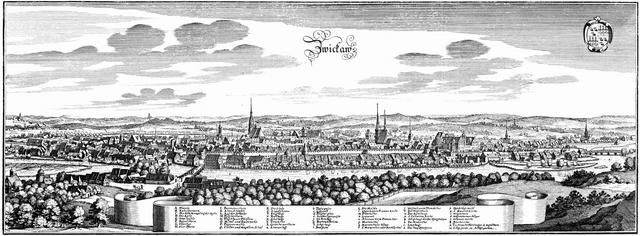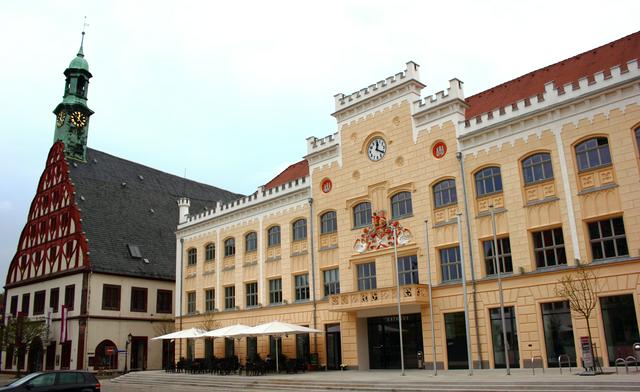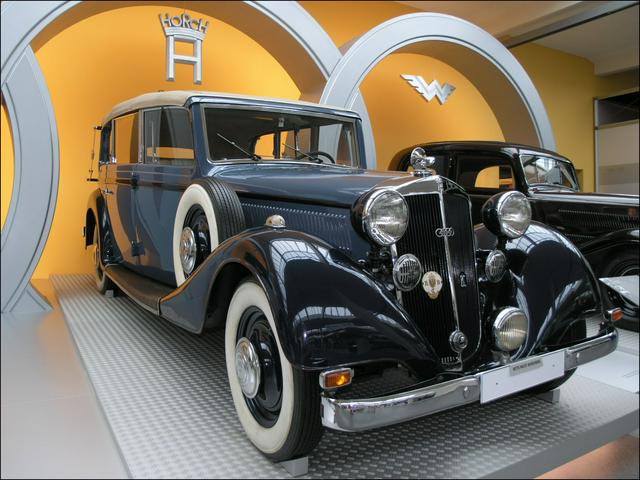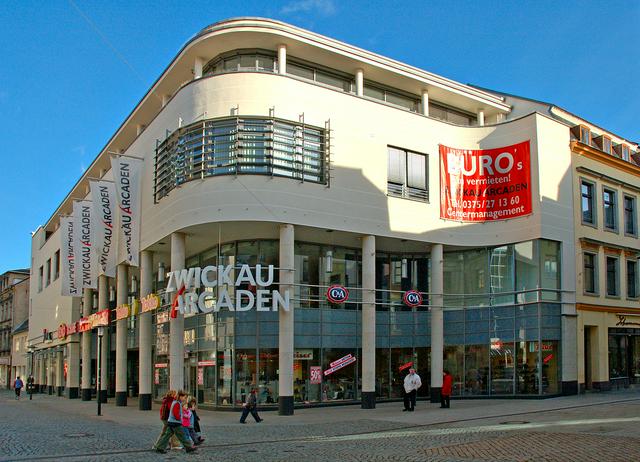Zwickau is a city in Saxony. Its rich history includes the facts that it is the birthplace of the 19th-century Robert Schumann and a number of automotive makes, most famously Horch and its junior companion brand Audi, which survives until today being based in Ingolstadt, and the post-war East German small car Trabant. Although neither of those brands survived until today in Zwickau, Volkswagen, now the owner of Audi, has built a factory in town.
 Zwickau's history dates back almost 900 years, being based on a settlement by the local Slavic tribes, called Šwikawa in Sorbian (a name referring to the pagan god Svarozič). It is located on, and gives its name to, the river Zwickauer Mulde, a tributary of the larger Mulde which in turn flows into the Elbe. The centre and most districts of Zwickau are on the left (western) bank of the river.
Zwickau's history dates back almost 900 years, being based on a settlement by the local Slavic tribes, called Šwikawa in Sorbian (a name referring to the pagan god Svarozič). It is located on, and gives its name to, the river Zwickauer Mulde, a tributary of the larger Mulde which in turn flows into the Elbe. The centre and most districts of Zwickau are on the left (western) bank of the river.
For many centuries, its economy has largely been based on coal and silver mining, predating the industrial revolution by centuries, which is why the city retained a very medieval type old town. Zwickau has always been a rather affluent and important town, even if remaining on the small side compared to other Saxon metropoles.
While a centre of a region that numbers around 500 000 inhabitants, Zwickau has only around 90 000 citizens, providing for a small town feel. That said, despite the rather unfortunate development during the DDR times, Zwickau retained a wealth of architectural heritage and a particular charm not found in the modernist Chemnitz, baroque Dresden or busy Leipzig.
- Tourist Information Centre Zwickau, http://www.zwickautourist.de/en/, +49 375 271 3240. The very friendly staff will eagerly help you with maps of the city and brochures of local attractions.
Tourist Information Centre Zwickau, http://www.zwickautourist.de/en/, +49 375 271 3240. The very friendly staff will eagerly help you with maps of the city and brochures of local attractions.
- Marienkirche.
- Priesterhäuser am Domhof. Some of the oldest existing residential buildings in Saxony, dating back to the 13th century.
- Galerie am Domhof. Built in 1876 as an art gallery and continues to house exhibitions
- Town Hall.

- Kräutergewölbe and Löwen-Apotheke. The buildings immediately facing the town hall were built as pharmacies in the late 15th century, some of the oldest buildings of that kind in Germany
- Gewandhaus. The former cloth merchant's hall is perhaps the most known historic building of Zwickau. Today, it houses a theatre.
- Robert Schumann House.
- Schiffchen. The corner building was designed to bear many marine inspirations. It was restored in the late 1960s to its original form from 1485.
- Dünnebierhaus. Restored to its former glory with a stepped gable this former merchant's house is now used to hold civil marriage ceremonies.
- St. Katharinenkirche. Another gothic church, which was completed throughout the 15th century.
- Schloss Osterstein. The former ducal residence was rescued and restored from a complete ruin in 2004-2008.
- Kornhaus. A granary from 1480
- Pulverturm. The (gun)powder tower and a small bit of the city wall are all that remains of the formerly magnificent medieval fortifications of Zwickau. Dwarfed by the prefab blocks behind it, the Pulverturm is now a pretty surreal sight.
- Paradiesbrücke. A pedestrian bridge from 1900 with restrained yet elegant decoration.
- Grünhainer Kapelle. The chapel with vaulted ceilings is the only remaining part of the once expansive cistercian convent.
- Landgericht Zwickau. An impressive, eclectic building from 1876
Marienkirche.
Priesterhäuser am Domhof. Some of the oldest existing residential buildings in Saxony, dating back to the 13th century.
Galerie am Domhof. Built in 1876 as an art gallery and continues to house exhibitions
Town Hall.
Kräutergewölbe and Löwen-Apotheke. The buildings immediately facing the town hall were built as pharmacies in the late 15th century, some of the oldest buildings of that kind in Germany
Gewandhaus. The former cloth merchant's hall is perhaps the most known historic building of Zwickau. Today, it houses a theatre.
Robert Schumann House.
Schiffchen. The corner building was designed to bear many marine inspirations. It was restored in the late 1960s to its original form from 1485.
Dünnebierhaus. Restored to its former glory with a stepped gable this former merchant's house is now used to hold civil marriage ceremonies.
St. Katharinenkirche. Another gothic church, which was completed throughout the 15th century.
Schloss Osterstein. The former ducal residence was rescued and restored from a complete ruin in 2004-2008.
Kornhaus. A granary from 1480
Pulverturm. The (gun)powder tower and a small bit of the city wall are all that remains of the formerly magnificent medieval fortifications of Zwickau. Dwarfed by the prefab blocks behind it, the Pulverturm is now a pretty surreal sight.
Paradiesbrücke. A pedestrian bridge from 1900 with restrained yet elegant decoration.
Grünhainer Kapelle. The chapel with vaulted ceilings is the only remaining part of the once expansive cistercian convent.
Landgericht Zwickau. An impressive, eclectic building from 1876

- August-Horch-Museum, Audistraße 7, 08058 Zwickau (Trams 4 and 7, buses 17 and 22 stop: Kaethe-Kollwitz Gymnasium, +49 375 271 73 812. 9:30-17:00 (last entry 16:30), first Thursday every month - until 20:00, closed on Mondays.
The museum in the former Audi factory in the north of Zwickau is devoted to the history of the factory and the Saxon automotive industry in general, and in particular the brands of the former Auto Union (Audi, DKW, Horch, Wanderer), and the post-war Sachsenring and Trabant vehicles, with a small section devoted to the recent Volkswagens manufactured in Zwickau. Over 3,000 square metres it houses a fantastic collection of cars manufactured there and in the related former Auto Union factories in Saxony, as well as prototypes, full of unique models such as the Sachsenring P240 Repräsentant. The collection is presented in a very attractive way, each car set against a reconstruction of a historic backdrop, with much space around to view it from almost every angle.
There is plentiful information pertaining to each car displayed, as well as general information related to the development of the particular companies, the automotive industry in general and in Saxony in particular, as well as automobile technology, with many interesting exhibits. Unfortunately, most of the information is in German only. An audiodguide in either German or English may be rented at the reception at an extra charge of €2.50. Guided tours are available upon appointment for €30.00 per group of up to 12 persons (every next person + €2.50). €5.50 entry (€3.50 reduced), groups >12 people €1.00 less. - Alter Gasometer. As in other European cities, new use for the large round building used as a gas storage for the city had to be found once gas delivery methods changed. Today, it houses a cultural centre
- Johannisbad, Johannisstraße 16, 08056 Zwickau.
-rfGMU.medium.jpg)
- Schwanenteich. The artificial pond was built by two local businessmen in the 19th century, and today the pond and the surrounding park are municipal property. It is called "the swan pond", and swans, the coat-of-arms animal of Zwickau, are indeed to be found there
- Nordvorstadt. This quarter is full of interesting late 19th century residential buildings. Stroll down Leipziger Straße or take any of the side streets and enjoy.
- Röhrensteg. An old wooden bridge from the 16th century
- Muldenwarte. A gazebo on the right bank of Zwickauer Mulde
- Krankenstift. The very decorative former hospital now houses a mini retail centre.
- Moritzkirche. A lushly decorated neogothic church from the 1890s
- Lutherkirche. A Jugendstihl church from the early 1900s.
August-Horch-Museum, Audistraße 7, 08058 Zwickau (Trams 4 and 7, buses 17 and 22 stop: Kaethe-Kollwitz Gymnasium, +49 375 271 73 812. 9:30-17:00 (last entry 16:30), first Thursday every month - until 20:00, closed on Mondays.
The museum in the former Audi factory in the north of Zwickau is devoted to the history of the factory and the Saxon automotive industry in general, and in particular the brands of the former Auto Union (Audi, DKW, Horch, Wanderer), and the post-war Sachsenring and Trabant vehicles, with a small section devoted to the recent Volkswagens manufactured in Zwickau. Over 3,000 square metres it houses a fantastic collection of cars manufactured there and in the related former Auto Union factories in Saxony, as well as prototypes, full of unique models such as the Sachsenring P240 Repräsentant. The collection is presented in a very attractive way, each car set against a reconstruction of a historic backdrop, with much space around to view it from almost every angle.
There is plentiful information pertaining to each car displayed, as well as general information related to the development of the particular companies, the automotive industry in general and in Saxony in particular, as well as automobile technology, with many interesting exhibits. Unfortunately, most of the information is in German only. An audiodguide in either German or English may be rented at the reception at an extra charge of €2.50. Guided tours are available upon appointment for €30.00 per group of up to 12 persons (every next person + €2.50). €5.50 entry (€3.50 reduced), groups >12 people €1.00 less.
Alter Gasometer. As in other European cities, new use for the large round building used as a gas storage for the city had to be found once gas delivery methods changed. Today, it houses a cultural centre
Johannisbad, Johannisstraße 16, 08056 Zwickau.
Schwanenteich. The artificial pond was built by two local businessmen in the 19th century, and today the pond and the surrounding park are municipal property. It is called "the swan pond", and swans, the coat-of-arms animal of Zwickau, are indeed to be found there
Nordvorstadt. This quarter is full of interesting late 19th century residential buildings. Stroll down Leipziger Straße or take any of the side streets and enjoy.
Röhrensteg. An old wooden bridge from the 16th century
Muldenwarte. A gazebo on the right bank of Zwickauer Mulde
Krankenstift. The very decorative former hospital now houses a mini retail centre.
Moritzkirche. A lushly decorated neogothic church from the 1890s
Lutherkirche. A Jugendstihl church from the early 1900s.
- Volkswagen Sachsen GmbH, Glauchauer Straße 40, 08058 Zwickau (visitors should arrive at the Western gate on the Nordstraße, +49 375 55 22 17. Tours take place Monday through Friday, between 9:30 AM and 12:00 noon. Volkswagen offers the possibility to visit the assembly plant in Zwickau, which builds Golfs and Passats, in groups from 10 to 25 people. An appointment is required, and all group members must be at least 14 years old. The plant tour encompasses the stamping press department, body welding and final assembly. There is a possibility of arranging for a lunch and arriving by bus, which can then be used to travel between the widely spaced halls of the factory.

Volkswagen Sachsen GmbH, Glauchauer Straße 40, 08058 Zwickau (visitors should arrive at the Western gate on the Nordstraße, +49 375 55 22 17. Tours take place Monday through Friday, between 9:30 AM and 12:00 noon. Volkswagen offers the possibility to visit the assembly plant in Zwickau, which builds Golfs and Passats, in groups from 10 to 25 people. An appointment is required, and all group members must be at least 14 years old. The plant tour encompasses the stamping press department, body welding and final assembly. There is a possibility of arranging for a lunch and arriving by bus, which can then be used to travel between the widely spaced halls of the factory.
- Zwickau Arcaden, Innere Plauensche Straße 14, 08056 Zwickau. The Arcaden shopping gallery fills an entire block in Zwickau's old town and features most of the local favourites in terms of retail chains. Of importance to travellers arriving by car may be the large parking facility, where one can pay both by cash and (most) cards.
Zwickau Arcaden, Innere Plauensche Straße 14, 08056 Zwickau. The Arcaden shopping gallery fills an entire block in Zwickau's old town and features most of the local favourites in terms of retail chains. Of importance to travellers arriving by car may be the large parking facility, where one can pay both by cash and (most) cards.
The Zwickauer Bürgersteak is a pork back steak filled with ham, gherkin, onions and mustard, which is fried in an egg shell.
- Citylight, Hauptmarkt 17/18, 08056 Zwickau.
- Basilikum, Leipziger Straße 180, 08058 Zwickau.
- Brasserie Philine's, Klosterstraße 1, 08056 Zwickau.
- No.9, Am Kornmarkt 9, 08056 Zwickau.
- Remarque, Bahnhofstraße 19, 08056 Zwickau.
Citylight, Hauptmarkt 17/18, 08056 Zwickau.
Basilikum, Leipziger Straße 180, 08058 Zwickau.
Brasserie Philine's, Klosterstraße 1, 08056 Zwickau.
No.9, Am Kornmarkt 9, 08056 Zwickau.
Remarque, Bahnhofstraße 19, 08056 Zwickau.
- Alte Mühle, Gewandhausstraße 7, 08056 Zwickau.
- Am Kreuzberg, Lengenfelder Straße 130, 08064 Zwickau.
- An der Reitbahn, Saarstraße 9, 08056 Zwickau.
- Gasthaus 1470, Marienstraße 50, 08056 Zwickau.
- Gasthof Schneppendorf, Jüdenhainer Straße 51, 08058 Zwickau.
- Mauritius Schänke, Bahnhofstraße 18, 08056 Zwickau.
- Park Eckersbach, Trillerplatz 1, 08066 Zwickau.
- Schnitzelparadies, Johannisstraße 16, 08056 Zwickau.
- Zum Dortmunder, Äußere Schneeberger Straße 30, 08056 Zwickau.
Alte Mühle, Gewandhausstraße 7, 08056 Zwickau.
Am Kreuzberg, Lengenfelder Straße 130, 08064 Zwickau.
An der Reitbahn, Saarstraße 9, 08056 Zwickau.
Gasthaus 1470, Marienstraße 50, 08056 Zwickau.
Gasthof Schneppendorf, Jüdenhainer Straße 51, 08058 Zwickau.
Mauritius Schänke, Bahnhofstraße 18, 08056 Zwickau.
Park Eckersbach, Trillerplatz 1, 08066 Zwickau.
Schnitzelparadies, Johannisstraße 16, 08056 Zwickau.
Zum Dortmunder, Äußere Schneeberger Straße 30, 08056 Zwickau.
- Barocco Bar, Römerstraße 22, 08056 Zwickau. bleah
- C. Ugly Bar, Marienthaler Straße 98, 08060 Zwickau.
- Destille, Peter-Breuer-Straße 12, 08056 Zwickau.
- Jamaica, Walther-Rathenau-Straße 20a, 08058 Zwickau.
- Maxim, Reichenbacher Straße 144, 08056 Zwickau.
- Stardust, Peter-Breuer-Straße 15, 08056 Zwickau.
- Tattoolounge, Peter-Breuer-Straße 10, 08056 Zwickau.
Barocco Bar, Römerstraße 22, 08056 Zwickau. bleah
C. Ugly Bar, Marienthaler Straße 98, 08060 Zwickau.
Destille, Peter-Breuer-Straße 12, 08056 Zwickau.
Jamaica, Walther-Rathenau-Straße 20a, 08058 Zwickau.
Maxim, Reichenbacher Straße 144, 08056 Zwickau.
Stardust, Peter-Breuer-Straße 15, 08056 Zwickau.
Tattoolounge, Peter-Breuer-Straße 10, 08056 Zwickau.
- ALEX, Hauptmarkt 11/12, 08056 Zwickau.
- Eisbar, Äußere Zwickauer Str. 46, 08064 Zwickau.
- EisKult, Poetenweg 4, 08056 Zwickau.
- Eiswerk, Marienstraße 70, 08056 Zwickau.
- Gran Gelato, Peter-Breuer-Straße 37, 08056 Zwickau.
ALEX, Hauptmarkt 11/12, 08056 Zwickau.
Eisbar, Äußere Zwickauer Str. 46, 08064 Zwickau.
EisKult, Poetenweg 4, 08056 Zwickau.
Eiswerk, Marienstraße 70, 08056 Zwickau.
Gran Gelato, Peter-Breuer-Straße 37, 08056 Zwickau.
- Club Seilerstraße, Seilerstraße 1b, 08056 Zwickau.
- Flash, Äußere Dresdner Straße 15, 08066 Zwickau.
- Moccabar, Humboldtstraße 14, 08056 Zwickau.
- Nachtwerk, Olzmannstraße 51, 08060 Zwickau.
- Palast Bar, Hauptstraße 8, 08056 Zwickau.
Club Seilerstraße, Seilerstraße 1b, 08056 Zwickau.
Flash, Äußere Dresdner Straße 15, 08066 Zwickau.
Moccabar, Humboldtstraße 14, 08056 Zwickau.
Nachtwerk, Olzmannstraße 51, 08060 Zwickau.
Palast Bar, Hauptstraße 8, 08056 Zwickau.
Zwickau is in the west of Saxony, the more urbanized part of the state:
- Plauen, beautiful relaxed city in the western extremity of Saxony, famous for its lace industry (approx. 0.5 hours with car via Autobahn or by train)
- Chemnitz, the largest city in Western Saxony, formerly Karl-Marx-Stadt (approx. 0.5 hours with car via Autobahn)
- Dresden, the lush baroque capital of Saxony (approx. 1 hour with car via Autobahn or by train)
- Leipzig, the largest city in Saxony famous for centuries for its trade fairs and since 1813 for the Battle of Nations (approx. 1 hour with car via local roads)
Being in the southwest of Saxony, Zwickau is also reasonably close to many cities in Thuringia and Bavaria:
